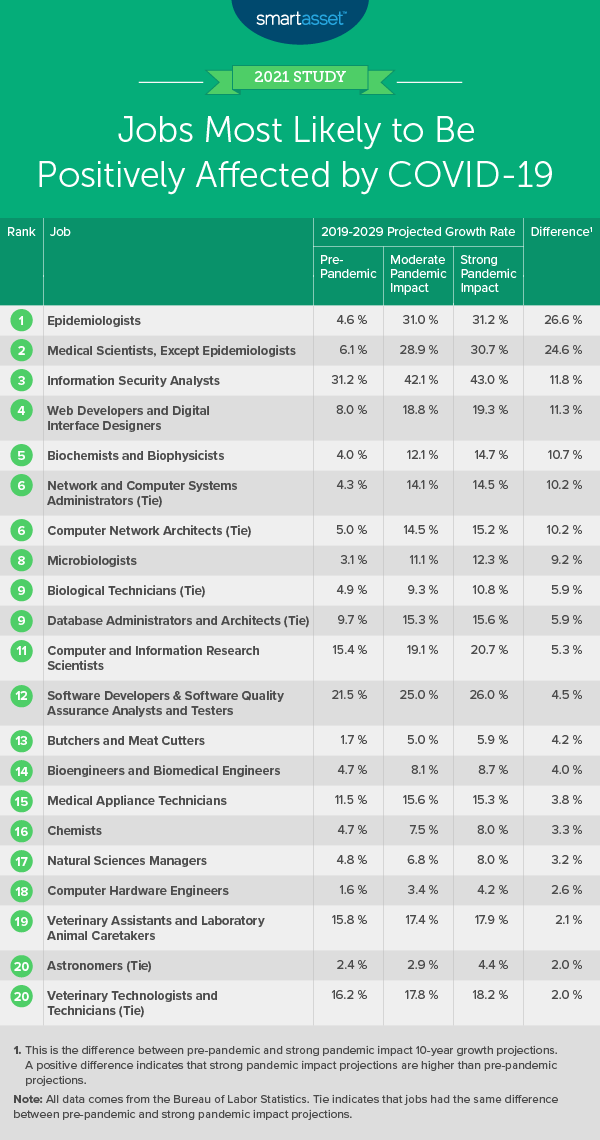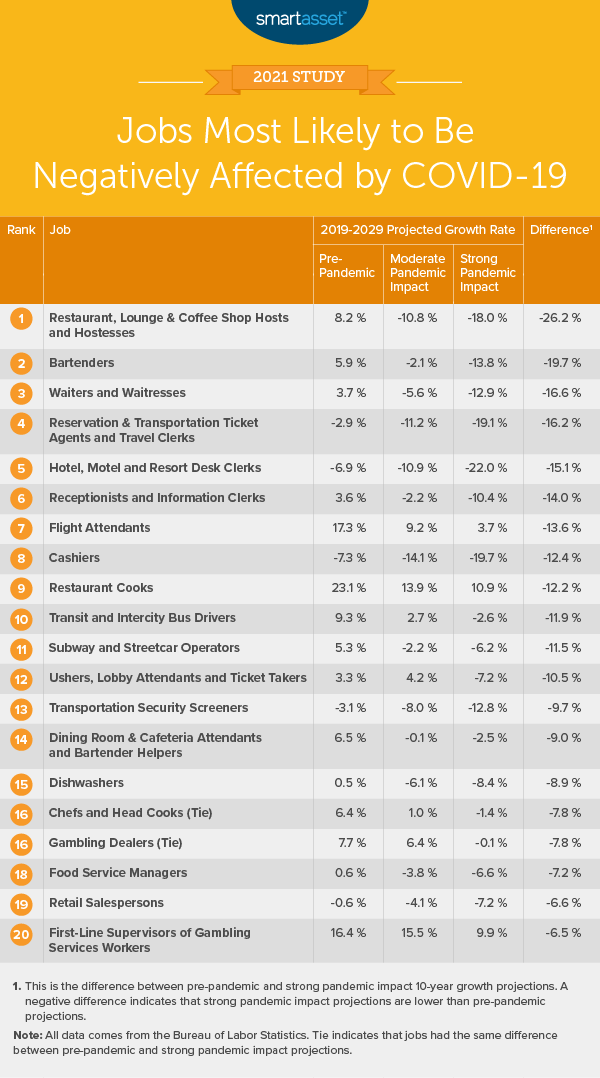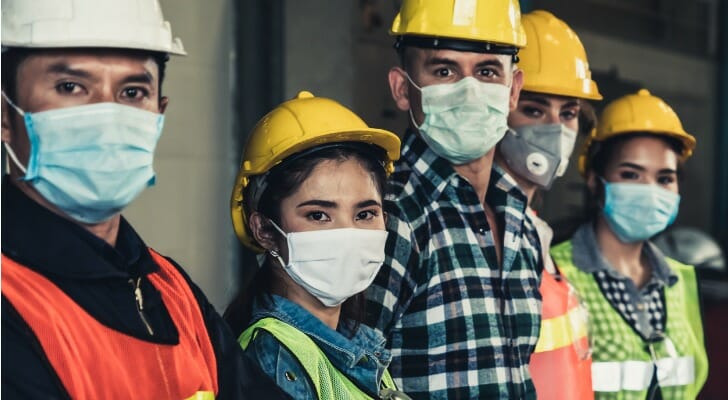While many economists believe that the U.S. economy will return to pre-pandemic levels by late 2021, they are less confident that the job market will bounce back as quickly. According to February data from the National Association of Business Economics, 82% of economic forecasters surveyed expect real GDP to return to pre-COVID-19 recession levels sometime in 2021. By contrast, only 59% of respondents anticipate the total number of workers (excluding farm workers) will return to pre-pandemic levels in 2023 or later. As Americans scramble to boost their savings and map out their job prospects during the pandemic, SmartAsset analyzed data from 720 occupations to project the long-term impact of COVID-19 on the job market.
In this study, we use data from the Bureau of Labor Statistics (BLS) to examine the coronavirus pandemic’s long-term impact on specific occupations. The BLS annually publishes 10-year growth projections for all industries and jobs in the U.S. After publishing 2019-2029 projections in the fall of 2020 that did not capture the effects of the pandemic, the BLS issued alternate scenarios that model how jobs might be impacted if COVID-19 continues to have either a moderate impact on the economy, or a strong one. We compare pre-pandemic and strong pandemic impact projections to determine the jobs that could be affected most positively or negatively by COVID-19. For details on our data sources and how we put all the information together to create our findings, check out the Data and Methodology section below.
Key Findings
- Almost three million less jobs. Prior to the COVID-19 pandemic, the BLS projected that six million jobs would be added to the U.S. economy from 2019 to 2029. In their revised strong pandemic impact scenario, less than 3.1 million jobs will be added over that time. With a total of about 163 million workers in 2019, the strong pandemic impact scenario represents an almost two percentage point drop in the preliminary 10-year employment growth projection, from 3.7% to 1.9%.
- About four in five jobs may experience lower 10-year job growth due to COVID-19. Of the total 720 occupations we considered, strong pandemic impact projections are lower than pre-pandemic estimates for 560 of them, or about 78%. BLS data shows there is no difference between pre-pandemic and strong pandemic impact projections for 50 jobs (6.94%) and that 110 jobs (15.28%) may see increased growth than previously expected.
- Restaurant, lounge, coffee shop and bar jobs face the most uncertainty. The BLS’ moderate impact scenario assumes that increased remote work is the primary change in the U.S. economy. However, its strong impact scenario accounts for more widespread and permanent changes to consumer and business behavior, whereby both consumers and businesses continue to limit human interaction. As a result, many of the occupations with the largest negative differences between pre-pandemic and strong pandemic impact projections are concentrated in service industries. The three jobs with the largest decreases in expected job growth are restaurant, lounge & coffee shop hosts and hostesses (8.2% to -18.0%); bartenders (5.9% to -13.8%) and waiters and waitresses (3.7% to -12.9%).
Jobs Most Likely to Be Positively Affected
Two occupations that focus on the research of diseases – epidemiologists and medical scientists – rank as the jobs most likely to be positively affected. Prior to COVID-19, the BLS predicted that over the next 10 years the occupations of epidemiologists and medical scientists would grow by 4.6% and 6.1%, respectively. But now the BLS predicts that they will grow by 31.0% and 28.9%, respectively, in the moderate pandemic impact scenario and by 31.2% and 30.7%, respectively, in the strong pandemic impact scenario.
Three other life, physical & social science occupations rank in the top 10 jobs most likely to be positively affected, reflecting the likelihood that more lab research will continue over the next decade. They are biochemists & biophysicists, microbiologists and biological technicians. Projections for all three jobs were more than four percentage points higher in the moderate pandemic impact scenario and more than five percentage points higher in the strong pandemic impact scenario than pre-pandemic projections.
The expansion of remote work will drive demand for information technology (IT) and computer-related occupations, particularly ones involved in IT security, as noted by the BLS. With the change in demand, the remaining five occupations in our top 10 are all computer & mathematical occupations:
- Information security analysts
- Web developers and digital interface designers
- Network and computer systems administrators
- Computer network architects
- Database administrators and architects
Information security analysts handle IT for a variety of business and financial companies. Computer network architects design and build communication networks, while network and computer systems administrators are responsible for the day-to-day operation of computer networks.

Jobs Most Likely to Be Negatively Affected
Job growth estimates dropped more than 10 percentage points for 12 jobs. Beyond the three service industry occupations listed above – restaurant, lounge & coffee shop hosts and hostesses; bartenders as well as waiters and waitresses – other jobs affected this drastically include receptionists, flight attendants and cashiers. Across all 12 jobs, flight attendants and restaurant cooks are the only two with expected positive job growth in the strong pandemic impact projections, despite the growth rate being lower than initially projected. Prior to COVID-19, the BLS predicted that over the next 10 years the occupations of flight attendants and restaurant cooks would grow by 17.3% and 23.1%, respectively. The BLS predicts that they will grow by 9.2% and 13.9%, respectively, in the moderate pandemic impact scenario and by 3.7% and 10.9%, respectively, in the strong pandemic impact scenario.
Notably, there are large differences between the moderate and strong pandemic impact scenarios for many of the jobs likely to be negatively affected. For example, in the strong pandemic impact scenario, the number of bartenders may decline by almost 14% from 2019 to 2029. By contrast, BLS projections show that the number of bartenders may only decline by 2.1% over the next 10 years in the moderate pandemic impact scenario. The table below shows the top 20 jobs most likely to be negatively affected by the continuation of COVID-19 and its economic effects.

Data and Methodology
Data for this report comes from the Bureau of Labor Statistics’ (BLS) employment projections. We considered initial 2019-2029 projections that do not account for COVID-19 along with two alternate scenarios: a moderate impact scenario and a strong impact scenario. The alternate scenarios identify occupations whose employment trajectories are subject to higher levels of uncertainty. The BLS does not intend them to be precise estimates of employment change over the projection period.
To rank the jobs most likely to be positively and negatively affected by COVID-19, we compared pre-COVID-19 pandemic and strong pandemic impact scenario projections for a total of 720 occupations. We calculated the percentage point difference between those two projections. A positive difference indicates that strong pandemic impact projections are higher than pre-COVID-19 pandemic projections and that those jobs are more likely to be positively affected. A negative difference indicates that strong pandemic impact projections are lower than pre-COVID-19 pandemic projections and that those jobs are more likely to be negatively affected. Though we did not use the moderate impact scenario numbers in ranking occupations, we used them qualitatively to evaluate less severe lasting effects of the pandemic on certain jobs.
Tips for Improving Your Savings in Preparation for a Financial Downturn
- If possible, keep your budget top of mind. One of the best ways to save more, and bolster your emergency savings if you can, is through budgeting. Our budget calculator can help with this. Beyond looking at how much you spend each month and what six months of expenses would look like, you can see how cutting back on discretionary expenses can increase your savings rate.
- Consider professional help. A financial advisor can help you make smarter financial decisions to be in better control of your money and navigate the current market. Finding a financial advisor doesn’t have to be hard. SmartAsset’s free tool matches you with financial advisors in five minutes. If you’re ready to be matched with advisors, get started now.
Questions about our study? Contact us at press@smartasset.com.
Photo credit: ©iStock.com/Blue Planet Studio
